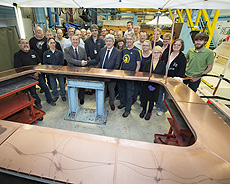Final piece of large magnet built at Fermilab arrives at Jefferson Lab
 |
| Fermilab Director Nigel Lockyer shakes hands with Jefferson Lab Director Hugh Montgomery by a superconducting coil and its development and fabrication team at Fermilab. Six coils have been made and shipped to Jefferson Lab for use in the CLAS12 experiment. Photo: Reidar Hahn
|
A group of Fermilab physicists and engineers was faced with a unique challenge when Jefferson Lab asked them to make the superconducting coils for an upgrade to their CEBAF Large Acceptance Spectrometer experiments. These are some of the largest coils Fermilab has ever built.
Despite obstacles, the sixth coil was completed, packed on a truck and sent to Jefferson Lab to become the last piece of the torus magnet in the lab's CLAS detector. It arrived on Thursday.
The CLAS detector's upgrade (CLAS12) will allow it to accept electron beams of up to 11 GeV, matching the beam energy of the Virginia laboratory's CEBAF electron accelerator after five passes. These improvements will allow Jefferson Lab to more accurately study the properties of atomic nuclei.
A major component of the enhanced detector is the torus magnet, which will be made from the six superconducting coils created at Fermilab. Aside from cleaning, insulating and winding the coils, one of the most important parts of the process is vacuum epoxy impregnation. During this step, air and water vapor are removed from the coils and replaced with an epoxy.
This process is particularly difficult when you're working on magnets as big as the CLAS12 coils, which are 14 feet long and seven feet wide. Fermilab's Magnet Systems Department fabrication team, the group responsible for making these massive coils, encountered a major obstacle at the end of March 2014 after finishing the first practice coil.
What they found were dry areas within the coil where the epoxy couldn't penetrate. These were places where the coils weren't fixed into place, meaning they could move and generate heat and resistance. This can lead to magnet quench, the transition from superconducting to a normal state — a highly undesirable consequence.
The Fermilab group and Jefferson Lab staff collaborated to come up with a solution. By trying new materials, new temperature profiles and adjusting the time that the epoxy was left to sit and be adsorbed, the team was able to prevent the dry areas from forming.
Fred Nobrega, the lead engineer at Fermilab for the CLAS12 coil project, joined the effort last August.
"It was rewarding for me to join the project near its low point, be able to help get through the hurdle and see this completed," he said.
Production has been steady since December, with Fermilab sending roughly one coil a month to Jefferson Lab. Although the sixth coil will become the last piece of the torus magnet, the project isn't complete just yet — the ultimate goal is to make eight identical coils, the six for the magnet and two spares.
"We're succeeding because we have great people and a productive collaboration with Jefferson Lab, who helped us at difficult moments," said George Velev, head of the Magnet Systems Department. "We worked together on a tough problem and now we see the results."
—Diana Kwon
|